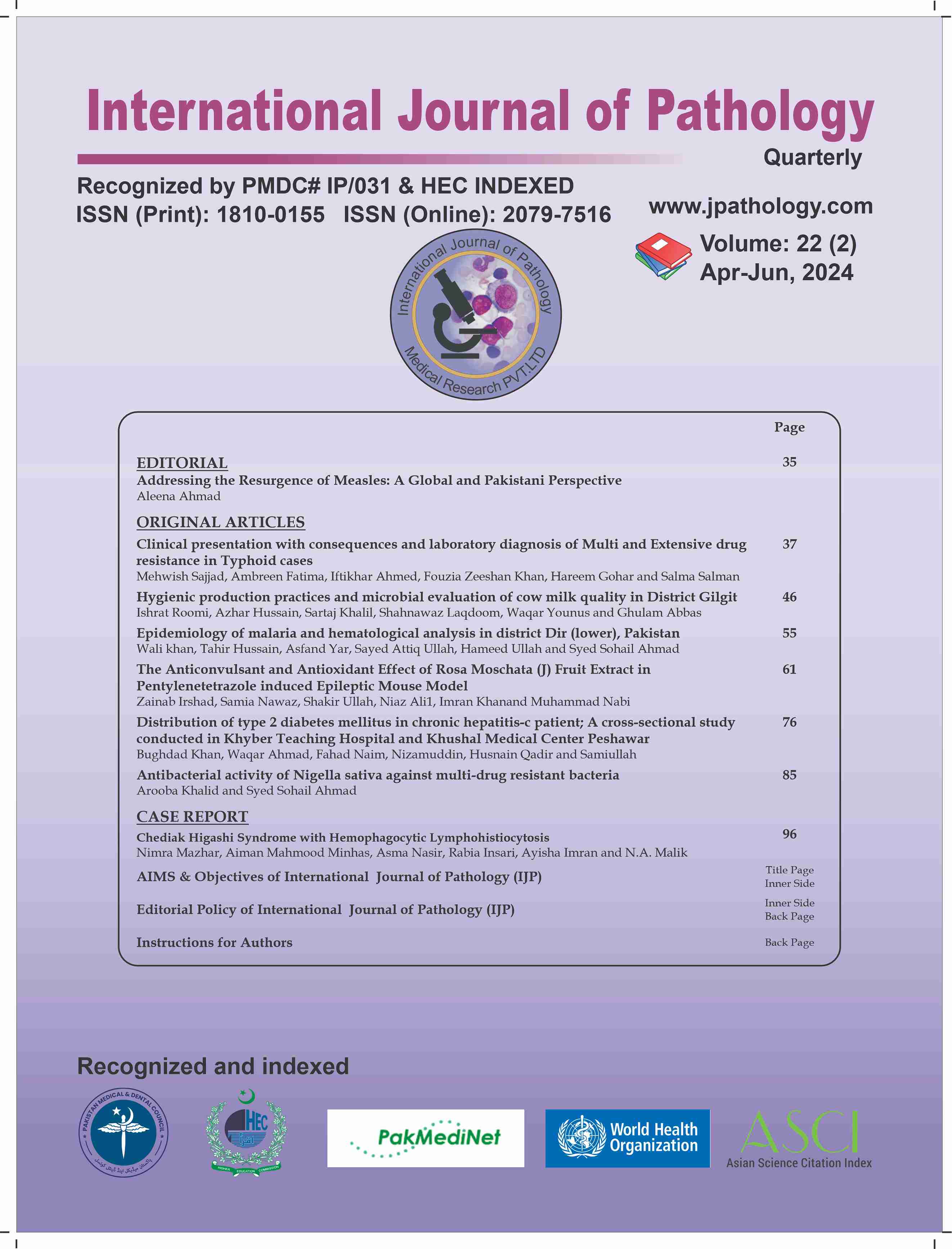Antibacterial activity of Nigella sativa against multi-drug resistant bacteria
DOI:
https://doi.org/10.59736/IJP.22.02.899Keywords:
multi drug resistance, Nigella sativa, Antibacterial ActivityAbstract
Background: Multidrug Resistant (MDR) bacteria are considered as the one of the most dangerous pathogens causing a high mortality rate globally. Medicines from the natural source might be the best therapeutic option in current emerging trends of resistance. Methods: We determined the antibacterial activity of Nigella sativa seeds extracts against the clinical isolates of MDR Staphylococcus aureus and Escherichia coli. The collection of different isolates was done from the different hospitals’ settings in Faisalabad. Identifications of these isolates were done phenotypically and through the conventional PCR via genus and species-specific primers. The isolates were then tested for antimicrobial susceptibility using agar well diffusion technique. The activity of N. sativa seed oil was also evaluated in DMSO at concentrations (25%, 50% and 75%). Results: Against S. aureus, 50% oil concentration in DMSO exhibited highest inhibitory zone of 15 mm followed by 90% ethanol extract showed clear zone of 13 mm and 12 mm zone of inhibition showed by the methanol-based extract. Against E. coli 50% oil concentration in Dimethyl sulfoxide (DMSO) and 90% ethanol extract both showed clear zone of 12 mm and 11 mm zone of inhibition showed by the methanol-based extract. However, Minimum inhibitory concentration (MIC) of 50% oil concentration is 0.4 μl followed by 90% ethanol extract showed 0.4 mg and 0.8 mg showed by the methanol-based extract 90% on S. aureus. The oil concentration MIC value of 50% is 0.4 μl then followed by the ethanol extract at 90% and revealed 0.4mg and methanol was followed by 90% extract showed 0.4 mg to the E. coli. Conclusion: We concluded that N. sativa can be used as a pharmaceutical and new therapy for action against MDR bacteria.
References
Abdullah, S. W., Gul, S. A., Farheen, S., Kibrea, T., Saleem, A., Gul, S. S., & Ahmad, U. (2018). Detection of Escherichia coli and total microbial population in River Siran water of Pakistan using Emb and Tpc agar. African Journal of Microbiology Research, 12(38), 908-912.
Abu Taha, A., Abu‐Zaydeh, A., Ardah, R., Al‐Jabi, S., Sweileh, W., Awang, R., & Zyoud, S. (2016). Public knowledge and attitudes regarding the use of antibiotics and resistance: findings from a cross‐sectional study among Palestinian adults. Zoonoses and public health, 63(6), 449-457.
Ahmad, S. S., Siddiqui, M. F., Maqbool, F., Ullah, I., Adnan, F., Albutti, A., . . . Rahman, Z. (2024). Combating Cariogenic Streptococcus mutans Biofilm Formation and Disruption with Coumaric Acid on Dentin Surface. Molecules, 29(2), 397.
Ajayi, A., Oniha, M., Atolagbe, O., & Onibokun, E. (2017). Studies on Staphylococcus aureus isolated from pimples. Pakistan Journal of Biological Sciences.
Aminov, R. (2017). History of antimicrobial drug discovery: Major classes and health impact. Biochemical pharmacology, 133, 4-19.
Burki, T. K. (2018). Superbugs: an arms race against bacteria. The Lancet Respiratory Medicine, 6(9), 668.
Cornejo-Juárez, P., Vilar-Compte, D., Pérez-Jiménez, C., Namendys-Silva, S., Sandoval-Hernández, S., & Volkow-Fernández, P. (2015). The impact of hospital-acquired infections with multidrug-resistant bacteria in an oncology intensive care unit. International Journal of Infectious Diseases, 31, 31-34.
Khaertynov, K. S., Anokhin, V. A., Rizvanov, A. A., Davidyuk, Y. N., Semyenova, D. R., Lubin, S. A., & Skvortsova, N. N. (2018). Virulence Factors and Antibiotic Resistance of Klebsiella pneumoniae Strains Isolated From Neonates With Sepsis. Front Med (Lausanne), 5, 225. doi:10.3389/fmed.2018.00225
Navidinia, M. (2016). The clinical importance of emerging ESKAPE pathogens in nosocomial infections.
Navidinia, M., Goudarzi, M., Rameshe, S. M., Farajollahi, Z., Asl, P. E., & Mounesi, M. R. (2017). Molecular characterization of resistance genes in MDR-ESKAPE pathogens. J Pure Appl Microbiol, 11(2), 779-792.
Sánchez, E., Morales, C. R., Castillo, S., Leos-Rivas, C., García-Becerra, L., & Martínez, D. M. O. (2016). Antibacterial and antibiofilm activity of methanolic plant extracts against nosocomial microorganisms. Evidence-Based Complementary and Alternative Medicine: eCAM, 2016.
Santajit, S., & Indrawattana, N. (2016). Mechanisms of antimicrobial resistance in ESKAPE pathogens. BioMed research international, 2016.
Sharikh, S. M., & Rao, J. U. P. (2020). A Study of Antibacterial Effect of Nigella Sativa Seed Extract on Clinical Isolates of Methicillin-Resistant Staphylococcus Aureus (MRSA). EXECUTIVE EDITOR, 11(7), 1516.
Downloads
Published
Issue
Section
License
Copyright (c) 2024 Arooba Khalid , Syed Sohail Ahmad

This work is licensed under a Creative Commons Attribution-NonCommercial 4.0 International License.
Readers may “Share-copy and redistribute the material in any medium or format” and “Adapt-remix, transform, and build upon the material”. The readers must give appropriate credit to the source of the material and indicate if changes were made to the material. Readers may not use the material for commercial purpose. The readers may not apply legal terms or technological measures that legally restrict others from doing anything the license permits.


